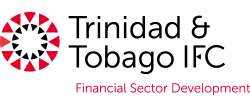The Unbanked and the Importance of Increasing Financial Inclusion
Submitted by Michelle Salandy, PhD
Improving financial inclusion is an important milestone for all economies and is one of the key mandate pillars of the Trinidad and Tobago International Financial Centre (T&T IFC). Financial inclusion refers to individuals and businesses that have access to useful, sustainable, and affordable financial products and services that meet their transaction, payment, saving, credit, and insurance needs (World Bank 2018). The concept of financial inclusion is multidimensional and covers several demand and supply side indicators such as account ownership, penetration of financial access points, and availability, use, and quality of services. However, whilst this is broadly recognised, it is commonly measured or referenced by the level of account ownership since it is viewed as one of the first and most basic steps to improving financial inclusion.
Reducing the unbanked, narrowing the apparent inequalities of the financial divide, and improving financial inclusion has been broadly viewed as critical to economic development as the World Bank views it, “not as an end in itself, but a means to an end”. Financial inclusion has also been identified by the United Nations as an enabler for several of the seventeen Sustainable Development Goals (SDGs). These include SDG1 on eradicating poverty; SDG 2 on ending hunger, achieving food security, and promoting sustainable agriculture; SDG 3 on profiting health and well-being; SDG 5 on achieving gender equality and economic empowerment of women; SDG 8 on promoting economic growth and jobs; SDG 9 on supporting industry, innovation, and infrastructure; and SDG 10 on reducing inequality. SDG 17 also provides an implicit role for greater financial inclusion through greater savings mobilisation for investment and consumption that can spur growth.
UN Sustained Development Goals

Source: United Nations
These benefits of increasing financial inclusion have been resoundingly clear for several economies. Financial inclusion has given many people the means to improve their own lives and manage their health, educational, and nutritional needs. Increased access to savings and credit are critical to persons living in extreme poverty as it would allow them to better manage unexpected risks, source capital for investment, and reduce the cost of everyday purchases. In India for example, government effort to open banks in rural areas helped cut rural poverty by up to 17 percentage points. The introduction of M-PESA (a mobile money service) in Kenya lifted as many as 194,000 households or 2 percent of the population out of poverty (World Bank 2018).
The cost of remittances has also been reduced by as much as 3 percent in some cases on account of greater financial inclusion and the provision of access to cheaper digital options (Pazarbasioglu et al. 2020). Remittances are an important source of finance for developing countries with large migrant populations and can even surpass their level of Foreign Direct Investment. Thus, this reduced cost not only provides for a greater stream of income and foreign exchange but reduces the burden on migrant remitters. This added income can then be tapped by its receivers and allow for consumption smoothing among individual households.
Improvement in equality is also another added benefit. The research shows that providing access to financial services in Mexico increased income by 7 percent in areas where bank branches were rapidly opened in more than 800 retail stores (Klapper, El-Zoghbi, and Hess 2016). Broader access to, and participation in the financial system can also boost job creation for Micro, Small and Medium Enterprises (MSMEs). Access to microcredit from formal banking channels allows MSMEs to access capital loans to expand their businesses. Improvements in financial inclusion have also been key to tackling some of the barriers that women face, closing gender gaps and effectively improving the economic lives of poor women and members of female-headed households. For instance, a study in Kenya shows that greater access to financial services reduced extreme poverty among women-headed households by 22 percent as it allowed 185,000 women to leave farming and develop business or retail activities (World Bank 2018).
Greater financial inclusion is also linked to reduced leakages and Government’s reliance on cash-only payments for social welfare disbursements or other subsidies. Direct deposits to accounts of intended recipients reduce the chance of theft and reduce opportunities for corruption and leakages due to errors or postal delays. For example, distributing pension payments through biometric smart cards rather than cash in India, reduced the leakage of funds by 47 percent (World Bank ECA Economic Update 2019). Additionally, switching the monthly payment of government social benefits from cash to mobile phones in Niger also benefited the recipients by reducing their overall travel and wait time to obtain payments by 20 hours on average (World Bank 2018).
Financial inclusion is instrumental in increasing investment and growth. At the macroeconomic level financial inclusion is correlated with greater employment and output as businesses including MSMEs can increase investment to expand their business. Cull, Ehrbeck and Holle (2014) has cited lower transaction costs and better distribution of capital and risk as the main mechanisms which support these benefits across economies. Case studies on Malawi farmers showed that the direct deposit of income in their bank account increased spending on equipment by 13 percent and boosted their crop yield by 21 percent. Insured farmers in Ghana also bought more fertilisers, planted more acreage, hired more workers, and had higher yields and income.
REFERENCES
Cull Robert, Ehrbeck Tilman, and Holle Nina.2014. Financial Inclusion and Development: Recent Impact Evidence. CGAP Focus Note 92.
Klapper Leora, El-Zoghbi Mayada, and Hess Jake. 2016. Achieving the Sustainable Development Goals the Role of Financial Inclusion. CGAP: Washington, DC.
Pazarbasioglu Ceyla, Mora Garcia Alfonso, Uttamchandani Mahesh, Natarajan Harish, Feyen Erik, and Saal Mathew. 2020. Digital Financial Services.
United Nations. Sustainable Development Goals.
World Bank ECA Economic Update. 2019. Financial Inclusion: Europe and Central Asia Economic Update.
World Bank. 2018. Financial Inclusion: Financial inclusion is a key enabler to reducing poverty and boosting prosperity.
